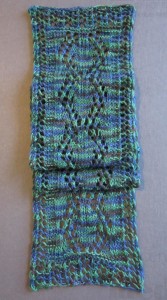 Depending on where you are in your lace knitting journey, Spring Lace Leaves Scarf can give you opportunities to
Depending on where you are in your lace knitting journey, Spring Lace Leaves Scarf can give you opportunities to
– learn something new,
– reinforce and grow confident in your skills,
– simply be inspired and enjoy the ride.
This scarf is worked from end to end in one long rectangular piece with a knit-as-you-go border framing the 4 sides. Please review The Roadmap to get an overview of the construction and acquaintance with the terminology for the Outer Border, Inner Border and Main Area.
You can start knitting anytime you are ready. I will be posting commentary and tips over the next couple of weeks. Please ask questions anytime and write about your own progress in the comments area of the knit-along page or any of the posts.
You Know More than You Realize
Ruth wrote: “I will definitely get started today. I’m sooo excited!
This will be my first attempt at lace knitting.“
First off, I want to say to those like Ruth who have recently joined in and might think lace knitting is going to all be brand new, you might be surprised at how much you already know. There is no real mystery to the stitches used in most lace patterns. In fact, you probably know most of these already from your regular knitting.
In the Bit-size Tutorial You Know More than You Realize, I point out common basic stitches like those used in Spring Lace Leaves Scarf that you probably are already well familiar with. This handful of stitches serves as building blocks for a huge portion of lace knitting patterns. It is the combinations and sequence of working these stitches, plus sometimes others, that results in the beautiful lace patterns we admire.
Casting On
Because lace is usually knit more loosely than normal knitting, the cast on (as well as bound off) stitches should similarly be loose enough to be compatible with the target gauge after blocking.
What do I mean by that? You can use your favorite cast on rather than learning any new-fangled special cast on for lace. You just need to take into consideration a commonly overlooked fact that the distance between the stitches of the cast-on row is a big determinant in whether there is enough looseness in the cast on edge to stretch out as desired.
Please review the article Cast on for a Good Finish that is on my HeartStrings FiberArts website. I think you will find its tips and recommendations helpful in much of your knitting going forward.
Outer Border
The Outer Border is Herringbone Faggot lace pattern, a multiple of just 4 stitches. The cast on of 30 stitches accommodates 7 repeats of the 4-stitch multiple + a chain selvedge stitch at each end of the row; i.e.
1 selvedge + (7 x 4 for Herringbone) + 1 selvedge
Herringbone Faggot is just one row of lace repeated over and over. Since there is lace patterning on every row (i.e. yarn over holes), Herringbone Faggot is knitted lace. See Lace Knitting vs. Knitted Lace
Herringbone Faggot is also entirely reversible. Thus, technically there is no RS or WS designation so far in the pattern instructions for the scarf.
Even though Herringbone Lace is quite simple, if you are a beginner (or just easily distracted in your knitting like I sometimes am, lol) you might find it helpful to place stitch markers to delineate each 4-stitch multiple. This makes it easier to stay on track with each stitch multiple, and also to identify a problem area should your stitch count be off. You can also review Striving for Perfect Results – Part 1 and Part 2.
Transition Row Between Outer and Inner Border
An extra stitch will eventually be needed to accommodate the Main Area stitch pattern. After completing the lower Outer Border and before beginning the Inner Border, this is a good time to adjust the number of stitches to make the increase inconspicuous.
While working the Outer Border Increase Row, the strategy is to “hide” that extra stitch as an extra yarn over near the center of the row. Thus at completion of this transition row you will have 31 stitches.
Note: If you are using stitch markers, it is correct that the center multiple of Herringbone Lace will have been increased to 5 stitches.
Inner Border
The Inner Border is simple garter stitch. This non-lace stitch will delineate the Outer Border lace stitch pattern from the focal lace stitch pattern in the upcoming Main Area.
Note: If you are using stitch markers, remove any except those needed to section off the first and last multiple of Herringbone Lace.
The lower Inner Border of garter stitch is worked across the center 21 stitches of the row while keeping the 5 stitches at each end of the row in the established 4-stitch Herringbone Lace and chain selvedge stitch; i.e.
1 selvedge + 4 Herringbone + 21 Garter Stitch + 4 Herringbone + 1 selvedge
Check In Your Progress So Far
Hopefully this gets you off to a good start on your knitting. Remember that if you have questions or comments, give a shout-out here or on the main Knit-Alongs page.

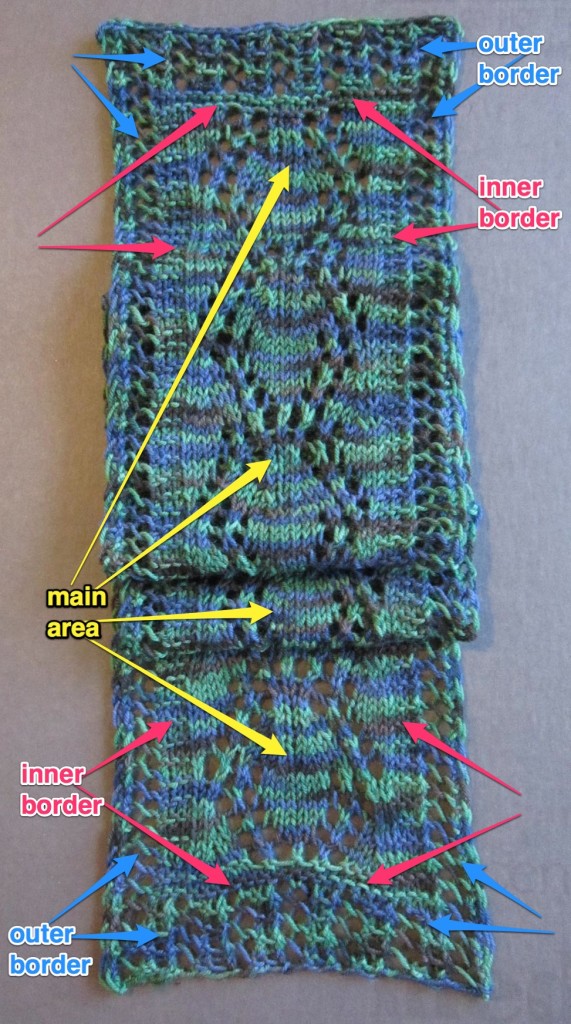


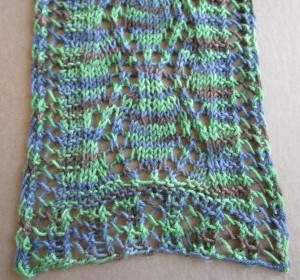
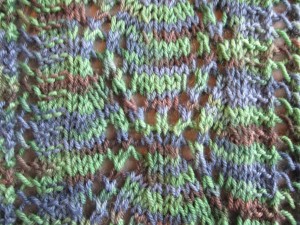
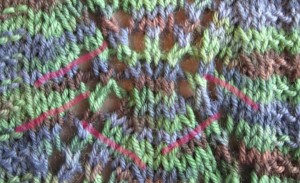


 HeartStrings FiberArts
HeartStrings FiberArts Knitting Bits of Lace on Facebook
Knitting Bits of Lace on Facebook Ravelry Store
Ravelry Store